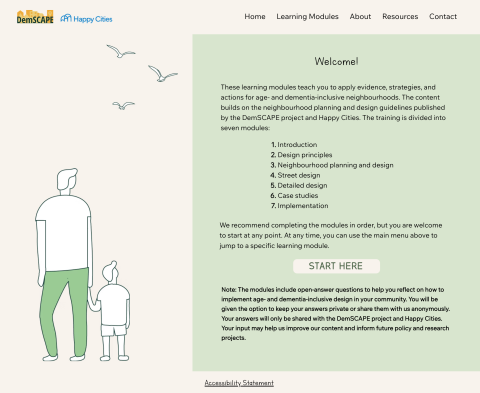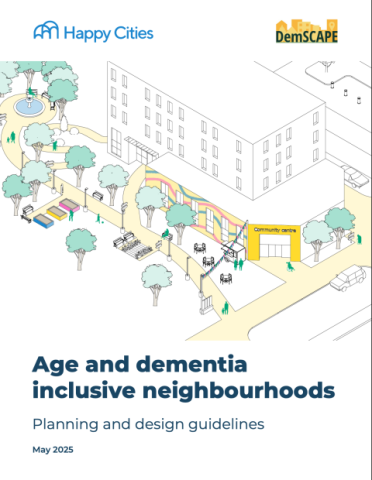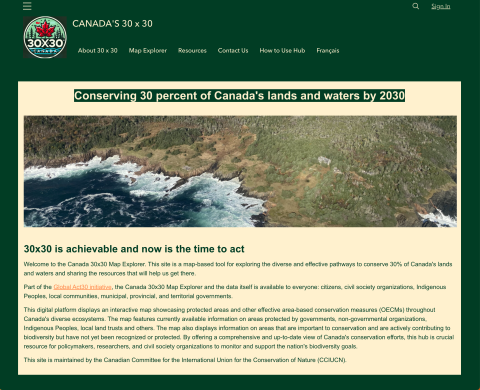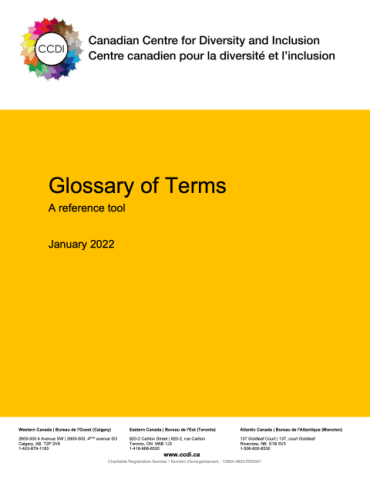Case studies serve as educational tools, bolster advocacy efforts, and empower CSLA members to make the business case for adaptation measures to their clients and/or target audiences.
CSLA Resource Library
Welcome to the CSLA Resource Library! Explore a wide range of landscape architecture-related research, reports, tools, videos and more—searchable by keyword, topic or type.
Have a resource you'd like to see included? Contact our team to share your suggestion.
Adaptation Case Studies
2024 – Case Study

CSLA/AAPC
Age and demntia inclusive neighbourhoods: Learning Modules
2025 – Online Course

Happy Cities / DemSCAPE
These learning modules teach you to apply evidence, strategies, and actions for age- and dementia-inclusive neighbourhoods. The content builds on the neighbourhood planning and design guidelines published by the DemSCAPE project and Happy Cities. The training is divided into seven modules: Introduction, Design principles, Neighbourhood planning and design, Street design, Detailed design, Case studies, and Implementation.
Age and demntia inclusive neighbourhoods: Planning and design guidelines
2025 – White Paper

Happy Cities / DemSCAPE
This document offers a toolkit of urban planning and design strategies to support wellbeing for older adults, with an added focus on people living with dementia. This document considers the needs of both older adults and people living with dementia, with clear strategies and actions that can support wellbeing for people of diverse ages, abilities, and life experiences. The guidelines can help municipalities, developers, community-based services, and individuals make informed decisions and advocate for more age-friendly, dementia-inclusive communities. The actions focus specifically on the role of the built environment in supporting wellbeing at three scales: the neighbourhood, the street, and detailed design.
AILA Climate Positive Design Guidelines. Volume 1 Climate positive design action plan for Australian landscape architects
2021 – White Paper

AILA
AILA’s Climate Positive Design Series will help guide your climate positive journey, we have three separate documents, targeting three specific areas of our work and practice. Volume 1 provides clear, simple advice on what Australian landscape architects can do to understand and deliver climate positive design through good planning, design, documentation, construction and renewal.
AILA Climate Positive Design Guidelines. Volume 2. Organisation guide to Climate Positive
2021 – White Paper

AILA
AILA’s Climate Positive Design Series will help guide your climate positive journey, we have three separate documents, targeting three specific areas of our work and practice. Volume 2 outlines the steps your practice, business or organisation can take to achieve carbon neutral certification and beyond to become climate positive.
AILA Climate Positive Design Guidelines. Volume 3 AILA roadmap to delivering climate positive design
2021 – White Paper

AILA
AILA’s Climate Positive Design Series will help guide your climate positive journey, we have three separate documents, targeting three specific areas of our work and practice. Volume 3 sets the framework, guidance and time frames for the AILA Executive and State groups to roll out climate positive design to members, and provide engagement and policy direction.
AILA Video Series: climate positive design short explainers
2021 – Webinar

AILA
"AILA’s Climate Positive Design Video Series will help guide your climate positive journey. Watch the climate positive design short explainers, on:
- What does climate positive design mean?
- How to measure your projects carbon.
- One big tree is worth a thousand small trees.
- Understanding carbon drawdown
- Understanding greenhouse emissions
- Advocacy
- Top Six Things you can do
- Mitigation toolkit
- Calculating your greenhouse emissions (custom elements)"
ASLA Climate Action Plan 2022-2025
2022 – Position Paper

ASLA
"The ASLA Climate Action Plan is rooted in three key goals and six key initiatives of IFLA Climate Action Commitment.
Our Vision for 2040: All landscape architecture projects will simultaneously: Achieve zero embodied and operational emissions and increase carbon sequestration; Provide significant economic benefits in the form of measurable ecosystem services, health co-benefits, sequestration, and green jobs; Address climate injustices, empower communities, and increase equitable distribution of climate investments; and Restore ecosystems and increase and protect biodiversity.
Goals Include: Practice: Scale Up Climate Positive Approaches; Equity: Empower Communities to Achieve Climate Justice; Advocacy: Build Coalitions for Climate Action"
ASLA Climate Field Guide
2022 – White Paper

ASLA
The purpose of this Field Guide is to help landscape architecture professionals and students become better climate advocates individually, as well as through firms, public institutions, nonprofit organizations, community groups, and ASLA’s chapters. For each of the plan’s six key initiatives, you can explore key climate actions to take: On your own, With your firm / organization, And with your community
Biodiversity Net Gain: A Path to Scalable Ecological Restoration | Alexandra Steed
2025 – Webinar

CSLA/AAPC
With ecological collapse looming large—potentially surpassing the threat of climate change—it’s clear that humanity’s alteration and exploitation of landscapes pose the greatest danger to global biodiversity. Landscape architects play a vital role in reversing this trend by planning and designing places that promote ecological resilience.
In this webinar, landscape architect Alexandra Steed will explore Biodiversity Net Gain (BNG), a framework for enhancing biodiversity through development. Drawing from her 20 years of experience in the UK and internationally, she will discuss practical approaches for scaling BNG, offering real-world examples. This session will provide tools for creating landscapes that restore and support biodiversity while contributing to global regeneration and climate adaptation.
Thursday, June 19, 2025 at 2:00 ET
Canada 30x30 Map Explorer
2025 – Tool

CC-IUCN
This site is a map-based tool for exploring the diverse and effective pathways to conserve 30% of Canada's lands and waters and sharing the resources that will help us get there. This digital platform displays an interactive map showcasing protected areas and other effective area-based conservation measures (OECMs) throughout Canada's diverse ecosystems. The map features currently available information on areas protected by governments, non-governmental organizations, Indigenous Peoples, local land trusts and others. The map also displays information on areas that are important to conservation and are actively contributing to biodiversity but have not yet been recognized or protected.
Canadian Centre for Diversity and Inclusion: Glossary of Terms, A reference Tool
2022 – Tool

CCDI
CCDI has developed a one-of-a-kind glossary of terms. This comprehensive glossary aims to provide a reference for anyone interested in terminology used within inclusion, diversity, equity, and accessibility (IDEA). It is our goal to create a comprehensive and accurate glossary, however there can be definitions that have evolved or have nuances that are missing. The nature of language is such that the meanings of words are often very subjective and based off context. If you notice something that should be added, updated, or removed while engaging with this glossary, please reach out to us at research@ccdi.ca.